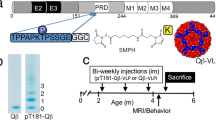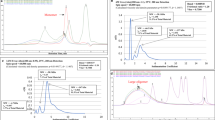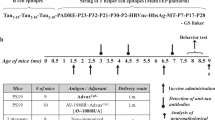Abstract
Transmissible spongiform encephalopathies (TSEs), also known as prion diseases, describe a group of fatal neurodegenerative disorders affecting both humans and animals. Accumulation of misfolded prion proteins is the pathological hallmark of these disorders; such accumulation occurs in lymphoreticular tissue prior to CNS involvement in scrapie, experimental models and human variant Creutzfeldt–Jakob disease. Lymphoreticular accumulation of misfolded prion protein has not been demonstrated in human sporadic or genetic forms of TSE. Once clinical symptoms develop, all prion disorders have a rapidly progressive and lethal course, and no effective therapy exists. In the past 10 years, antibody-based immunotherapy has been considered for other neurodegenerative disorders associated with protein misfolding and, therefore, might also be an effective approach to prevention or treatment of prion disease. Self-tolerance to endogenous prion protein is, however, a major challenge to the development of effective immunotherapy, as is the risk of adverse effects from active immunization. This Review summarizes the evidence that immunization could slow disease progression or increase lifespan in animal models of prion diseases. The therapeutic potential of these strategies in treating patients with prion diseases is also discussed.
Key Points
-
Prion diseases are lethal neurodegenerative disorders for which no effective therapy is currently available
-
Identification of an appropriate prion epitope and circumvention of self-tolerance are major obstacles to inducing a therapeutic immune response
-
Potential therapeutic approaches include active and passive immunization strategies involving endogenous or synthetic prion proteins
-
Promising results for both active and passive immunization strategies have been reported in animal models of prion diseases
-
Active immunization against prion proteins can induce an inflammatory response in the brain; passive immunization might, therefore, be a safer approach
This is a preview of subscription content, access via your institution
Access options
Subscribe to this journal
Receive 12 print issues and online access
$209.00 per year
only $17.42 per issue
Buy this article
- Purchase on Springer Link
- Instant access to full article PDF
Prices may be subject to local taxes which are calculated during checkout
Similar content being viewed by others
References
Prusiner, S. B. The prion diseases. Brain Pathol. 8, 499–513 (1998).
McKinley, M. P., Bolton, D. C. & Prusiner, S. B. A protease-resistant protein is a structural component of the scrapie prion. Cell 35, 57–62 (1983).
Collinge, J. Prion diseases of humans and animals: their causes and molecular basis. Annu. Rev. Neurosci. 24, 519–550 (2001).
Fraser, H. & Dickinson, A. G. Pathogenesis of scrapie in the mouse: the role of the spleen. Nature 226, 462–463 (1970).
Brown, P. Creutzfeldt–Jakob disease: reflections on the risk from blood product therapy. Haemophilia 13 (Suppl. 5), 33–40 (2007).
Hilton, D. A. et al. Specificity of lymphoreticular accumulation of prion protein for variant Creutzfeldt–Jakob disease. J. Clin. Pathol. 57, 300–302 (2004).
Glatzel, M., Abela, E., Maissen, M. & Aguzzi, A. Extraneural pathologic prion protein in sporadic Creutzfeldt–Jakob disease. N. Engl. J. Med. 349, 1812–1820 (2003).
Zerr, I. Therapeutic trials in human transmissible spongiform encephalopathies: recent advances and problems to address. Infect. Disord. Drug Targets 9, 92–99 (2009).
Dormont, D. Approaches to prophylaxis and therapy. Br. Med. Bull. 66, 281–292 (2003).
Brody, D. L. & Holtzman, D. M. Active and passive immunotherapy for neurodegenerative disorders. Annu. Rev. Neurosci. 31, 175–193 (2008).
Oesch, B. et al. A cellular gene encodes scrapie PrP 27–30 protein. Cell 40, 735–746 (1985).
Kretzschmar, H. A., Prusiner, S. B., Stowring, L. E. & DeArmond, S. J. Scrapie prion proteins are synthesized in neurons. Am. J. Pathol. 122, 1–5 (1986).
Harris, D. A. Cellular biology of prion diseases. Clin. Microbiol. Rev. 12, 429–444 (1999).
Bueler, H. et al. Normal development and behaviour of mice lacking the neuronal cell-surface PrP protein. Nature 356, 577–582 (1992).
Tobler, I. et al. Altered circadian activity rhythms and sleep in mice devoid of prion protein. Nature 380, 639–642 (1996).
Colling, S. B., Khana, M., Collinge, J. & Jefferys, J. G. Mossy fibre reorganization in the hippocampus of prion protein null mice. Brain Res. 755, 28–35 (1997).
Forloni, G. et al. A neurotoxic prion protein fragment induces rat astroglial proliferation and hypertrophy. Eur. J. Neurosci. 6, 1415–1422 (1994).
Whatley, S. A. et al. Regulation of intracellular free calcium levels by the cellular prion protein. Neuroreport 6, 2333–2337 (1995).
Brown, D. R., Schulz-Schaeffer, W. J., Schmidt, B. & Kretzschmar, H. A. Prion protein-deficient cells show altered response to oxidative stress due to decreased SOD-1 activity. Exp. Neurol. 146, 104–112 (1997).
Brown, D. R. & Mohn, C. M. Astrocytic glutamate uptake and prion protein expression. Glia 25, 282–292 (1999).
Mouillet-Richard, S. et al. Signal transduction through prion protein. Science 289, 1925–1928 (2000).
Weise, J. et al. Upregulation of cellular prion protein (PrPc) after focal cerebral ischemia and influence of lesion severity. Neurosci. Lett. 372, 146–150 (2004).
Weise, J. et al. Deletion of cellular prion protein results in reduced Akt activation, enhanced postischemic caspase-3 activation, and exacerbation of ischemic brain injury. Stroke 37, 1296–1300 (2006).
Hoshino, S. et al. Prions prevent brain damage after experimental brain injury: a preliminary report. Acta Neurochir. Suppl. 86, 297–299 (2003).
Schmitt-Ulms, G. et al. Binding of neural cell adhesion molecules (N-CAMs) to the cellular prion protein. J. Mol. Biol. 314, 1209–1225 (2001).
Spielhaupter, C. & Schatzl, H. M. PrPC directly interacts with proteins involved in signaling pathways. J. Biol. Chem. 276, 44604–44612 (2001).
Kurschner, C. & Morgan, J. I. Analysis of interaction sites in homo- and heteromeric complexes containing Bcl-2 family members and the cellular prion protein. Brain Res. Mol. Brain Res. 37, 249–258 (1996).
Chiarini, L. B. et al. Cellular prion protein transduces neuroprotective signals. EMBO J. 21, 3317–3326 (2002).
Chen, S., Mange, A., Dong, L., Lehmann, S. & Schachner, M. Prion protein as trans-interacting partner for neurons is involved in neurite outgrowth and neuronal survival. Mol. Cell. Neurosci. 22, 227–233 (2003).
Lopes, M. H. et al. Interaction of cellular prion and stress-inducible protein 1 promotes neuritogenesis and neuroprotection by distinct signaling pathways. J. Neurosci. 25, 11330–11339 (2005).
Vassallo, N. et al. Activation of phosphatidylinositol 3-kinase by cellular prion protein and its role in cell survival. Biochem Biophys. Res. Commun. 332, 75–82 (2005).
Skovronsky, D. M., Lee, V. M. & Trojanowski, J. Q. Neurodegenerative diseases: new concepts of pathogenesis and their therapeutic implications. Annu. Rev. Pathol. 1, 151–170 (2006).
Parkin, E. T. et al. Cellular prion protein regulates β-secretase cleavage of the Alzheimer's amyloid precursor protein. Proc. Natl Acad. Sci. USA 104, 11062–11067 (2007).
Cisse, M. & Mucke, L. Alzheimer's disease: a prion protein connection. Nature 457, 1090–1091 (2009).
Kellett, K. A. & Hooper, N. M. Prion protein and Alzheimer disease. Prion 3, 190–194 (2009).
Wang, V., Chuang, T. C., Soong, B. W., Shan, D. E. & Kao, M. C. Octarepeat changes of prion protein in Parkinson's disease. Parkinsonism Relat. Disord. 15, 53–58 (2009).
Heppner, F. L. et al. Transepithelial prion transport by M cells. Nat. Med. 7, 976–977 (2001).
Aguzzi, A. & Sigurdson, C. J. Antiprion immunotherapy: to suppress or to stimulate? Nat. Rev. Immunol. 4, 725–736 (2004).
Daude, N. Prion diseases and the spleen. Viral Immunol. 17, 334–349 (2004).
Kimberlin, R. H. & Walker, C. A. The role of the spleen in the neuroinvasion of scrapie in mice. Virus Res. 12, 201–211 (1989).
Montrasio, F. et al. Impaired prion replication in spleens of mice lacking functional follicular dendritic cells. Science 288, 1257–1259 (2000).
Klein, M. A. et al. A crucial role for B cells in neuroinvasive scrapie. Nature 390, 687–690 (1997).
Klein, M. A. et al. PrP expression in B lymphocytes is not required for prion neuroinvasion. Nat. Med. 4, 1429–1433 (1998).
Mabbott, N. A. et al. Tumor necrosis factor alpha-deficient, but not interleukin-6-deficient, mice resist peripheral infection with scrapie. J. Virol. 74, 3338–3344 (2000).
Aguzzi, A. et al. Immune system and peripheral nerves in propagation of prions to CNS. Br. Med. Bull. 66, 141–159 (2003).
Nicotera, P. A route for prion neuroinvasion. Neuron 31, 345–348 (2001).
Glatzel, M., Heppner, F. L., Albers, K. M. & Aguzzi, A. Sympathetic innervation of lymphoreticular organs is rate limiting for prion neuroinvasion. Neuron 31, 25–34 (2001).
Prinz, M. et al. Positioning of follicular dendritic cells within the spleen controls prion neuroinvasion. Nature 425, 957–962 (2003).
Aguzzi, A. & Zhu, C. Five questions on prion diseases. PLoS Pathog. 8, e1002651 (2012).
Vella, L. J., Sharples, R. A., Nisbet, R. M., Cappai, R. & Hill, A. F. The role of exosomes in the processing of proteins associated with neurodegenerative diseases. Eur. Biophys. J. 37, 323–332 (2008).
Vella, L. J. & Hill, A. F. Generation of cell lines propagating infectious prions and the isolation and characterization of cell-derived exosomes. Methods Mol. Biol. 459, 69–82 (2008).
Leblanc, P. et al. Retrovirus infection strongly enhances scrapie infectivity release in cell culture. EMBO J. 25, 2674–2685 (2006).
Alais, S. et al. Mouse neuroblastoma cells release prion infectivity associated with exosomal vesicles. Biol. Cell 100, 603–615 (2008).
Schenk, D. et al. Immunization with amyloid-β attenuates Alzheimer-disease-like pathology in the PDAPP mouse. Nature 400, 173–177 (1999).
Morgan, D. et al. A beta peptide vaccination prevents memory loss in an animal model of Alzheimer's disease. Nature 408, 982–985 (2000).
Bard, F. et al. Peripherally administered antibodies against amyloid β-peptide enter the central nervous system and reduce pathology in a mouse model of Alzheimer disease. Nat. Med. 6, 916–919 (2000).
Porter, D. D., Porter, H. G. & Cox, N. A. Failure to demonstrate a humoral immune response to scrapie infection in mice. J. Immunol. 111, 1407–1410 (1973).
Kasper, K. C., Stites, D. P., Bowman, K. A., Panitch, H. & Prusiner, S. B. Immunological studies of scrapie infection. J. Neuroimmunol. 3, 187–201 (1982).
Aucouturier, P. & Carnaud, C. The immune system and prion diseases: a relationship of complicity and blindness. J. Leukoc. Biol. 72, 1075–1083 (2002).
Spinner, D. S. et al. CpG oligodeoxynucleotide-enhanced humoral immune response and production of antibodies to prion protein PrPSc in mice immunized with 139A scrapie-associated fibrils. J. Leukoc. Biol. 81, 1374–1385 (2007).
Polymenidou, M. et al. Humoral immune response to native eukaryotic prion protein correlates with anti-prion protection. Proc. Natl Acad. Sci. USA 101 (Suppl. 2), 14670–14676 (2004).
Krasemann, S., Groschup, M. H., Harmeyer, S., Hunsmann, G. & Bodemer, W. Generation of monoclonal antibodies against human prion proteins in PrP0/0 mice. Mol. Med. 2, 725–734 (1996).
Demart, S. et al. New insight into abnormal prion protein using monoclonal antibodies. Biochem. Biophys. Res. Commun. 265, 652–657 (1999).
Bainbridge, J. & Walker, B. Cell mediated immune responses against human prion protein. Clin. Exp. Immunol. 133, 310–317 (2003).
Gregoire, S. et al. Identification of two immunogenic domains of the prion protein--PrP--which activate class II-restricted T cells and elicit antibody responses against the native molecule. J. Leukoc. Biol. 76, 125–134 (2004).
Kim, C. L. et al. Antigenic characterization of an abnormal isoform of prion protein using a new diverse panel of monoclonal antibodies. Virology 320, 40–51 (2004).
Khalili-Shirazi, A. et al. Protein conformation significantly influences immune responses to prion protein. J. Immunol. 174, 3256–3263 (2005).
Nakamura, N. et al. Generation of antibodies against prion protein by scrapie-infected cell immunization of PrP0 mice. Hybrid Hybridomics 22, 263–266 (2003).
Trevitt, C. R. & Collinge, J. A systematic review of prion therapeutics in experimental models. Brain 129, 2241–2265 (2006).
Muller-Schiffmann, A. & Korth, C. Vaccine approaches to prevent and treat prion infection: progress and challenges. BioDrugs 22, 45–52 (2008).
Arbel, M., Lavie, V. & Solomon, B. Generation of antibodies against prion protein in wild-type mice via helix 1 peptide immunization. J. Neuroimmunol. 144, 38–45 (2003).
Bainbridge, J., Jones, N. & Walker, B. Multiple antigenic peptides facilitate generation of anti-prion antibodies. Clin. Exp. Immunol. 137, 298–304 (2004).
Souan, L. et al. Modulation of proteinase-K resistant prion protein by prion peptide immunization. Eur. J. Immunol. 31, 2338–2346 (2001).
Schwarz, A. et al. Immunisation with a synthetic prion protein-derived peptide prolongs survival times of mice orally exposed to the scrapie agent. Neurosci. Lett. 350, 187–189 (2003).
Bachy, V. et al. Mouse vaccination with dendritic cells loaded with prion protein peptides overcomes tolerance and delays scrapie. J. Gen. Virol. 91, 809–820 (2010).
Koller, M. F., Grau, T. & Christen, P. Induction of antibodies against murine full-length prion protein in wild-type mice. J. Neuroimmunol. 132, 113–116 (2002).
Sigurdsson, E. M. et al. Immunization delays the onset of prion disease in mice. Am. J. Pathol. 161, 13–17 (2002).
Ishibashi, D. et al. Immunization with recombinant bovine but not mouse prion protein delays the onset of disease in mice inoculated with a mouse-adapted prion. Vaccine 25, 985–992 (2007).
Tayebi, M., Collinge, J. & Hawke, S. Unswitched immunoglobulin M response prolongs mouse survival in prion disease. J. Gen. Virol. 90, 777–782 (2009).
Ishibashi, D. et al. Antigenic mimicry-mediated anti-prion effects induced by bacterial enzyme succinylarginine dihydrolase in mice. Vaccine 29, 9321–9328 (2011).
Rosset, M. B. et al. Dendritic cell-mediated-immunization with xenogenic PrP and adenoviral vectors breaks tolerance and prolongs mice survival against experimental scrapie. PLoS ONE 4, e4917 (2009).
Bade, S., Baier, M., Boetel, T. & Frey, A. Intranasal immunization of Balb/c mice against prion protein attenuates orally acquired transmissible spongiform encephalopathy. Vaccine 24, 1242–1253 (2006).
Goni, F. et al. High titers of mucosal and systemic anti-PrP antibodies abrogate oral prion infection in mucosal-vaccinated mice. Neuroscience 153, 679–686 (2008).
Bayer, A. J. et al. Evaluation of the safety and immunogenicity of synthetic Aβ42 (AN1792) in patients with AD. Neurology 64, 94–101 (2005).
Schenk, D. Amyloid-β immunotherapy for Alzheimer's disease: the end of the beginning. Nat. Rev. Neurosci. 3, 824–828 (2002).
Solforosi, L. et al. Cross-linking cellular prion protein triggers neuronal apoptosis in vivo. Science 303, 1514–1516 (2004).
Klohn, P. C. et al. PrP antibodies do not trigger mouse hippocampal neuron apoptosis. Science 335, 52 (2012).
Heppner, F. L. et al. Prevention of scrapie pathogenesis by transgenic expression of anti-prion protein antibodies. Science 294, 178–182 (2001).
Sigurdsson, E. M. et al. Anti-prion antibodies for prophylaxis following prion exposure in mice. Neurosci. Lett. 336, 185–187 (2003).
White, A. R. et al. Monoclonal antibodies inhibit prion replication and delay the development of prion disease. Nature 422, 80–83 (2003).
Sadowski, M. J. et al. Anti-PrP Mab 6D11 suppresses PrPSc replication in prion infected myeloid precursor line FDC-P1/22L and in the lymphoreticular system in vivo. Neurobiol. Dis. 34, 267–278 (2009).
Zuber, C. et al. Anti-LRP/LR antibody W3 hampers peripheral PrPSc propagation in scrapie infected mice. Prion 1, 207–212 (2007).
Gauczynski, S. et al. The 37-kDa/67-kDa laminin receptor acts as a receptor for infectious prions and is inhibited by polysulfated glycanes. J. Infect. Dis. 194, 702–709 (2006).
Gauczynski, S. et al. The 37-kDa/67-kDa laminin receptor acts as the cell-surface receptor for the cellular prion protein. EMBO J. 20, 5863–5875 (2001).
Leucht, C. et al. The 37 kDa/67 kDa laminin receptor is required for PrPSc propagation in scrapie-infected neuronal cells. EMBO Rep. 4, 290–295 (2003).
Zuber, C. et al. Single chain Fv antibodies directed against the 37 kDa/67 kDa laminin receptor as therapeutic tools in prion diseases. Mol. Immunol. 45, 144–151 (2008).
Wei, X. et al. Human anti-prion antibodies block prion peptide fibril formation and neurotoxicity. J. Biol. Chem. 287, 12858–12866 (2012).
Kellner, A. et al. Autoantibodies against β-amyloid are common in Alzheimer's disease and control plaque burden. Ann. Neurol. 65, 24–31 (2009).
Dodel, R. C. et al. Intravenous immunoglobulins containing antibodies against β-amyloid for the treatment of Alzheimer's disease. J. Neurol. Neurosurg. Psychiatry 75, 1472–1474 (2004).
Relkin, N. R. et al. 18-month study of intravenous immunoglobulin for treatment of mild Alzheimer disease. Neurobiol. Aging 30, 1728–1736 (2009).
Dorban, G., Defaweux, V., Heinen, E. & Antoine, N. Spreading of prions from the immune to the peripheral nervous system: a potential implication of dendritic cells. Histochem. Cell Biol. 133, 493–504 (2010).
Du, Y. et al. Human anti-β-amyloid antibodies block β-amyloid fibril formation and prevent β-amyloid-induced neurotoxicity. Brain 126, 1935–1939 (2003).
Dodel, R. et al. Naturally occurring autoantibodies against β-amyloid: investigating their role in transgenic animal and in vitro models of Alzheimer's disease. J. Neurosci. 31, 5847–5854 (2011).
Acknowledgements
This work was supported by a research grant of the University Medical Center Giessen and Marburg. Y. Roettger received a research grant from the Competence network Degenerative Dementias, funded by the German Ministry of Education and Research (BMBF, 01GI1008C). The article was edited for language errors by editors from American Journal Experts.
Author information
Authors and Affiliations
Contributions
Y. Roettger, J.-P. Bach and R. Dodel researched the data for the article. Y. Roettger, Y. Du, M. Bacher, I. Zerr, R. Dodel and J.-P. Bach provided substantial contributions to discussion of the content, review and/or editing of the manuscript before submission. Y. Roettger and J.-P. Bach wrote the article.
Corresponding author
Ethics declarations
Competing interests
M. Bacher, R. Dodel and J.-P. Bach hold patent applications 20090028869 and 2366714 A1. J.-P. Bach has received research grants from Grifols and Baxter. In addition, he has received lecturing fees from Teva Pharmaceuticals. The other authors declare no competing interests.
Rights and permissions
About this article
Cite this article
Roettger, Y., Du, Y., Bacher, M. et al. Immunotherapy in prion disease. Nat Rev Neurol 9, 98–105 (2013). https://doi.org/10.1038/nrneurol.2012.258
Published:
Issue Date:
DOI: https://doi.org/10.1038/nrneurol.2012.258
This article is cited by
-
Rapidly progressive dementias — aetiologies, diagnosis and management
Nature Reviews Neurology (2022)
-
Prion-Like Propagation of Post-Translationally Modified Tau in Alzheimer’s Disease: A Hypothesis
Journal of Molecular Neuroscience (2018)
-
Combined immunotherapy with “anti-insulin resistance” therapy as a novel therapeutic strategy against neurodegenerative diseases
npj Parkinson's Disease (2017)
-
The immunobiology of prion diseases
Nature Reviews Immunology (2013)


